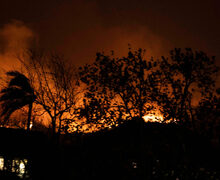Roth: Trip to desert highlights Chile’s geographic diversity
With a stray dog trailing along, my friends and I walked to the edge of the 2,500-person town of San Pedro de Atacama. This dusty little town is located in the center of the Atacama Desert, one of the driest and most beautiful deserts in the world. It’s also one of the best places to stargaze, which is exactly what my friends and I were doing.
With the lights of the town to our backs, we looked out and saw flat desert — no buildings, nada. The nearly full moon illuminated the distant mountain range. Even with the bright moon, the sky was full of more stars than I’ve seen in my life.
Last night, I tried to look at the stars from my backyard in Santiago. I probably saw more people walking around at night in San Pedro than stars in Santiago’s sky —about 10, counting my friends and the dog following us.
Really, the desert is another world entirely from where I’ve been traveling in Chile. It’s about a 24-hour bus ride, or a 2-hour flight plus an hour-long drive from the metropolis of Santiago. Santiago is so huge that it takes at least one bus or metro to get anywhere outside of your neighborhood. San Pedro was so small that I’m not sure if it even had a bus system.
Because Chile forms the spine of South America, it’s an incredibly geographically diverse country—the Andes Mountains border the west, the beach along the east, lakes in the south and the desert to the north. If you include Chile’s claims to territory in Antarctica, the geography gets even more diverse. Santiago sits in the middle of these extremes with a comfortable climate similar to Los Angeles.
With about 6 million residents, Santiago has almost double the population of Los Angeles. The majority of Chileans live in cities, making rural areas like Atacama quite desolate. San Pedro was a nice refreshing break from the hurried daily life in Santiago.
San Pedro is the heart of tourism for the Atacama Desert. The town attracts 120,000 tourists per year. That’s 48 times greater than the population in the whole comuña, which is like a county. It’s filled with gift shops, overpriced restaurants, travel agencies, hostels and houses.
All the natural attractions like Valle de la Luna, or Valley of the Moon, and the Lagunas Antiplánicas, gorgeous lagoons that reflect the mountains perfectly, are about an hour’s drive from San Pedro. I’d gaze out the window on our drives and there would be nothing but desert, mountains, volcanoes and a very bright sun beating down on everything. No houses, no gas stations — just desert.
A lot of the desert looks like what I’d imagine Mars to look like. When we were at El Tatio, the third largest geyser field in the world, you could hear water rushing underneath the ground before the steam and water would gush up. The Valley of Death looked completely different with its vast, red sand. It was initially called Valley of Mars because it looks like the little red planet.
My friend noted that in the U.S., a tourist town like San Pedro would try to glamorize its dusty, desolate quaintness. But San Pedro just was desolate and relaxing without trying to be. There were three ATMs, you couldn’t drink the water and all the little houses were made of adobe.
San Pedro and the rest of the beautiful desert were a good break from the daily rush of life in Santiago. In less than two weeks, I’ll be going to Patagonia, which has the same mix of tourism and quietude. The environment will be rainy, wet and green, completely different than in Atacama, but still under the same flag and the same stars.
Danielle Roth is a junior majoring in magazine journalism and international relations. She is following her desires for good food and adventure in Santiago, Chile. Email her at dlroth@syr.edu or tweet at her @danielleroth_.
Published on November 18, 2014 at 12:01 am





